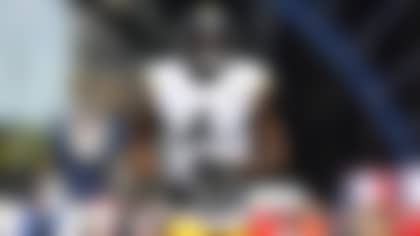The Dallas Cowboys have been widely hailed as a contender, but a leaky offensive line is threatening to derail their chances.
The unit has struggled mightily during the preseason, which has prevented one of the league's most explosive offenses from finding a consistent rhythm.
The Cowboys rank last in the league in total yards per game (248.2), and have allowed 15 sacks through four preseason games. While the constant shuttling of personnel in and out of the game skews those numbers, the fact that the Cowboys are averaging only four points in the first half is a direct reflection of the starting offensive line's inability to get defenders blocked up front.
Cowboys season preview
[ Get fearless forecasts from experts, pivotal games, players on the hot seat, fantasy analysis and more with NFL.com's team-by-team season previews.
**More ...**
Although some of the woes can be attributed to the injuries that have plagued the group (Kyle Kosier and Marc Colombo have missed significant time during training camp with knee injuries), there is no denying that the offensive line has been consistently outplayed at the point of attack. Opponents are routinely playing on the Cowboys' side of the line of the scrimmage, and the endless penetration is disrupting the offensive flow.
The team's vaunted rushing attack is only averaging 54.5 yards per game, and the combination of Felix Jones and Marion Barber have combined to average only 2.1 yards per carry without scoring once.
Tony Romo hasn't fared much better due to the protection woes. He has completed only 56.5 percent of his passes for 287 yards with one touchdown and two interceptions for a dismal 64.3 passer rating. Although Romo hasn't been in midseason form with his accuracy or placement, relentless pressure in his face has led to errant passes.
Given the explosive potential of the offense, the lack of production is an obvious cause for concern. More importantly, the inability to dominate the trenches is alarming. The Cowboys have always fielded massive offensive lines that pushed opponents around, but this preseason the unit has repeatedly come up short. Coupled with the team's disappointing postseason loss to the Minnesota Vikings, a disturbing trend is starting to emerge.
While a healthy return of Kosier and Colombo would go a long way towards solving the issue, the team needs significantly better play from Alex Barron, Montrae Holland and Doug Free to stay on track for a title run.
The Cowboys were penciled in as NFC favorites, but if the offensive line doesn't quickly rectify its issues, Super Bowl XLV might not be the "home" game that Jerry Jones envisioned.
Sanchez not progressing
After watching Mark Sanchez struggle through his second preseason as the Jets' starting quarterback, I'm beginning to think Pete Carroll might have been on to something when he suggested that his star pupil wasn't ready to enter the draft when he left USC as a junior in 2009.
Though Sanchez seemingly disproved his former college coach when he guided the Jets to the AFC title game, his ongoing struggles indicate he might not be ready for primetime.
All eyes on Sanchez
The Jets must understand Mark Sanchez is a good player, but can be great if managed correctly. This season could shape his career, says Michael Lombardi. **More ...**
In three preseason games, Sanchez has completed 64.6 percent of his passes for 270 yards with two touchdowns and two interceptions for a 75.9 passer rating. However, he is ultimately judged by the performance of the offense, and the unit hasn't looked like one capable of complementing a Super Bowl-caliber defense.
The first-team offense has only scored 28 points (two touchdowns and five field goals) in 17 possessions, and has turned the ball over three times with six punts and a missed field goal.
Although the Jets rode a pedestrian offense to within game of the Super Bowl a season ago, it is highly unlikely that the team can make a deep postseason run without a unit capable of matching the San Diego Chargers, Indianapolis Colts, Baltimore Ravens and New England Patriots in a playoff shootout.
While the onus was on Sanchez to raise the offense's level of play heading into the season, coach Rex Ryan and general manager Mike Tannenbaum tried to alleviate some of the pressure by adding a host of weapons. The Jets acquired Santonio Holmes in a trade with the Pittsburgh Steelers. The former Super Bowl MVP joined Braylon Edwards, Jerricho Cotchery and Dustin Keller to give Sanchez an upper-echelon receiving corps to lean on.
The team also added LaDainian Tomlinson to fortify its backfield. Though the move seems like an attempt to bolster the league's top-ranked rushing attack from a season ago, the acquisition actually upgrades the passing game due to Tomlinson's receiving ability.
Tomlinson is viewed as one of the top pass catchers out of the backfield, and he immediately becomes a valuable option as a safety valve.
Given a stellar supporting cast to foster his development, Sanchez was expected to make a monumental jump this season. However, he has still been plagued by the same problems that contributed to his up-and-down rookie year. Sanchez locks on to his primary receivers, and his reluctance to take the easy completion rather than the risky throw continues to result in costly turnovers.
Maybe those mistakes should be expected considering the limited experience (16 collegiate starts) that Sanchez had prior to entering the league. Though he logged 15 starts as a rookie, he has not had a lot of repetitions reading complex coverage. While the Jets have undoubtedly attempted to simulate things in practice, there is nothing that prepares a passer for the pace and tempo of game action.
Flaws in Favre's game?
If the Minnesota Vikings' first two games with Brett Favre back in the fold are any indication, opponents are set to unleash a blitzkrieg on the veteran.
Defensive coordinators have spent most of the offseason studying the New Orleans Saints' win over the Vikings in the NFC title game, and Gregg Williams' success against Favre has encouraged other play-callers to implement aggressive blitz tactics.
In watching the Vikings face the San Francisco 49ers and Seattle Seahawks this preseason, it was apparent that both teams aggressively came after the quarterback and the pressure clearly disrupted Favre's rhythm. Though he has connected on 63.0 percent of his passes, Favre has turned the ball over three times (two interceptions and one fumble) and taken two sacks. Of course, some of the ball-security woes can be blamed on rust, but Favre's propensity for turnovers has been an issue throughout his career.
Although Favre is deservedly recognized as one of the league's toughest players, some defensive coaches believe the veteran can be rattled and pressured into mistakes. As an AFC defensive coach told me last season, the best way to defend the Vikings is to put the game on Favre's shoulders, and force him to make plays under pressure. While the coach acknowledged Favre still has enough moxie to make plays, he also suggested that the QB will give the opposition plenty of chances and defenders must make him pay for his mistakes.
Last season, Favre kept those mistakes to a minimum when he completed 68.4 percent passes for 4,202 yards with 33 touchdowns and seven interceptions for a 107.2 passer rating. His completion percentage and passer rating represented career highs.
With the odds working against the 40-year old being able to duplicate his play from a year ago, especially battling a nagging ankle injury, defensive coordinators will continue to see if Favre can deliver under constant pressure.
Young Panthers on the prowl
The departure of Julius Peppers during free agency led most to write off the Carolina Panthers' pass rush, but the emergence of three youngsters might make the five-time Pro Bowler easy to forget.
Such a bold statement would've drawn raised eyebrows during the offseason, but the trio has helped the Panthers tally a league-leading 18 sacks through three preseason games.
Charles Johnson, Everette Brown and Greg Hardy have terrorized opponents off the edge, and their collective efforts have quietly made the defensive line a very formidable unit. Although they lack the flash and sizzle of their predecessor, their workmanlike approach has resulted in consistent pressure.
Teams with issues
Johnson, a fourth-year pro with only 10 career sacks, has become the leader of the unit after serving as a situational pass rusher during his first three seasons. Since getting a chance to do more, Johnson has impressed observers with his motor, energy and ability. Being able to win on second or third effort has allowed him to wear down blockers. He has two sacks this preseason, but his consistent presence in the backfield has forced opponents to start paying more attention to him. As he becomes the focus of opponents, the Panthers' other young rushers are taking advantage of single blocking on the backside.
Brown, a 2009 second-round pick, has started to show the explosive rush skills that made him a coveted prospect out of Florida State. As a designated speed rusher with an excellent first step, Brown has the potential to consistently press the edge relying solely on his athleticism. Though he struggled getting home as a rookie, he has developed a counter (spin move) that has allowed him to slip under offensive tackles when they set deeper to account for his speed. With three sacks in a few quarters of action, Brown looks poised to fill the role the team envisioned when they traded a first-round pick to secure his services.
The sleeper of the group is Hardy. The team's sixth-round pick has been a force and led some to wonder why he fell so far in the draft despite being a highly-productive player in the SEC. The slight has obviously motivated Hardy because he has been nearly unstoppable in limited action. He has three sacks and looks poised to contribute as a situational pass rusher as a rookie.




